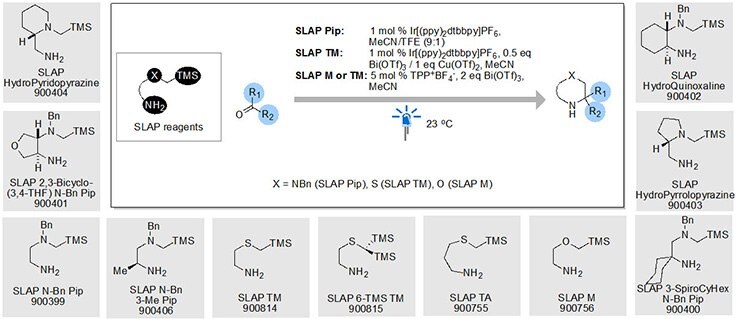SiLicon Amine Protocol (SLAP) Reagents
Introduction
The Bode group has recently developed and commercialized a number of SnAP (stannyl amine protocol) reagents that cross-couple with aldehydes and ketones to provide one-step access to a wide variety of saturated N-heterocycles, including morpholines, piperazines, thiomorpholines, oxazepines, and diazepines. Despite its broad substrate scope, this powerful methodology is perceived to have one main drawback − a reliance on potentially toxic tin reagents. To address this issue, we have developed SiLicon Amine Protocol (SLAP) reagents.
The expanding class of SLAP reagents provides access to piperazines from aromatic, heteroaromatic, and aliphatic aldehydes and ketones by using an iridium photoredox catalyst (747769) under exposure to blue light – without additional reagents or the generation of toxic byproducts. Several of the SLAP reagents are now available in the catalog and bespoke reagents can also be readily prepared.

Figure 1.SLAP reagent structures and related product numbers
Inclusion of a Lewis acid in the reaction also enables the transformation of SLAP reagents to thiomorpholines and thiazepanes. Morpholines and thiomorpholines can also be accessed using the alternative organic photocatalyst 2,4,6-triphenylpyrylium tetrafluoroborate (TPP·BF4, 272345). These conditions, particularly the use of the organic photocatalyst (TPP) and a Lewis acid additive, are readily applicable to flow chemistry, thus enabling the simple, scalable synthesis of substituted morpholines, oxazepanes, thiomorpholines and thiazepanes under continuous flow conditions.
Advantages
Due to the high chemical stability of the TMS group, a wide range of SLAP reagents can be readily prepared from commercially available building blocks and subsequently condensed with aldehydes and ketones, displaying the same remarkably high tolerance for unprotected functional groups that is seen with the SnAP reagents. Regardless of sterics or stereochemistry, all of the reagents are effective partners in the photocatalytic N-heterocycle formation. In all cases, the products are formed, under these very mild conditions, with excellent diastereoselectivity, in favor of the more thermodynamically stable isomers.

Figure 2.SLAP reagents and respective N-heterocycle product yields
SLAP reagent product list
General Procedure
General condition for imine formation:
A mixture of a SLAP reagent (0.5 mmol), an aldehyde (0.5 mmol), and MS 4A (100.0 mg) in MeCN (1.0 mL, 0.5 M) (for SLAP Pip reagents) or CH2Cl2 (1.0 mL, 0.5 M) (for SLAP TM and TA reagents) under N2 was stirred at room temperature overnight. The reaction was filtered through Celite and washed with CH2Cl2. The filtrate was condensed under vacuo and used directly for cyclization.
General condition for ketimine formation:
A mixture of a SLAP reagent (0.5 mmol), a ketone (0.5 mmol), and MS 4A (100.0 mg) in benzene (1.0 mL, 0.5 M) under N2 was stirred at reflux overnight. The reaction was filtered through Celite and washed with CH2Cl2. The filtrate was condensed under vacuo and used directly for cyclization.
General condition for photocatalytic cyclization (Piperazines):
The reaction was carried out in a closed vial (20 mL) (degassing and dry solvents not required). To a solution of the imine or ketimine (0.5 mmol, 1.00 equiv) in MeCN/TFE (9:1, 10.0 mL, 0.05 M), Ir[(ppy)2dtbbpy]PF6 (4.6 mg, 5.0 μmol, 0.01 equiv) was added. The reaction was stirred at rt under the exposure of blue LEDs (30 W) with a cooling fan to maintain the temperature. H2O (0.1 mL) was added and the reaction was stirred for another 5 min. The solvents were removed under vacuo and the residue was dissolved in CH2Cl2, dried over Na2SO4, filtered, and condensed under vacuo. Purified by flash column chromatography.
General condition for photocatalytic cyclization (Thiomorpholines, Thiazepanes, and Morpholines):
The reaction was carried out in a closed vial (7 mL) with no need to be degased beforehand or under dry conditions. To a solution of the corresponding imine or ketimine (0.5 mmol, 1.00 equiv) in MeCN (5.0 mL, 0.05 M), and either Cu(OTf)2 (180.8 mg, 0.50 mmol, 1.00 equiv)/Bi(OTf)3 (160.4 mg, 0.25 mmol, 0.5 equiv) (for thiomorpholiness and thiazepanes), and Ir[(ppy)2dtbbpy]PF6 (4.6 mg, 5.00 μmol, 0.01 equiv), or TMSOTf (144.4 mg, 0.65 mmol, 1.30 equiv) and TPP•BF4 (9.9 mg, 0.025 mmol, 5 mol%) (for morpholines) were added. The reaction was stirred for 16 or 48 h at room temperature under the exposure of blue LEDs (30 W) with a cooling fan to maintain the temperature. NH3(aq) (1 mL, ca. 12 M) was added and the reaction was stirred for another 10 min. After the solvents were removed under vacuo, the residue was re-dissolved in CH2Cl2/NH3(aq) and filtered through Celite. The filtrate was extracted with CH2Cl2 and the combined organic layers were washed with NH3(aq). The final organic extracts were dried over Na2SO4, filtered, and condensed under vacuo. The residue was purified by flash column chromatography to afford the desired product.
General procedure for the cyclization using the flow reactor
Depending on the SLAP reagent and the aldehyde three different procedures can be used:
(Procedure A): The imine (0.50 mmol, 1.00 equiv) was dissolved in 10:1 CH3CN/HFIP. The catalyst (0.03 mmol, 5mol%) and TMSOTf (0.65 mmol, 1.30 equiv) were added and the resulting solution was stirred for 3–5min. The mixture was subjected to the flow-reactor at a flow-rate of r = 0.10 mL/min under blue light irradiation. The reaction mixture was diluted with CH2Cl2 (15 mL) and a 10 % NH4OH solution (5 mL) was added. The phases were separated and the aqueous phase was extracted with CH2Cl2 (3 x 10mL). The organic phases were combined, washed with brine, dried over MgSO4 and concentrated under reduced pressure. The residue was purified by column chromatography to obtain the pure products.
(Procedure B): See Procedure A but 10 mol % of catalyst was used and the flow-rate was decreased to r = 0.06 mL/min.
(Procedure C): See Procedure A but 10 mol % of catalyst was used.
References
To continue reading please sign in or create an account.
Don't Have An Account?